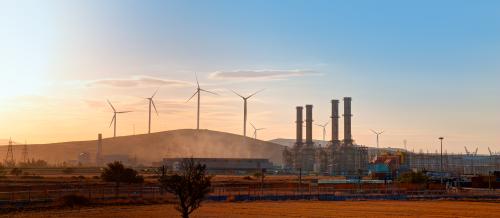The world is grappling with not one, but two existential challenges. On the one hand, it is urgent to raise minimum living standards and meet the aspirations of billions of people around the world who struggle to afford the full range of basic needs. On the other hand, equally important, is the imperative to protect the planet from the worst consequences of climate change. The extent to which we make concerted progress on both fronts in this decade will shape the course of the world for generations to come.
Real progress has been made on the first goal. Over the past three decades, some 1.3 billion people around the world have exited extreme poverty, which is commendable progress by any standard. But development experts argue that it is time to raise the bar. The extreme poverty line of $2.15 a day can get people to a level of bare subsistence, but aiming for a higher standard could deliver true economic empowerment. Research from the McKinsey Global Institute draws on the work of leading academics to frame this idea. The “empowerment line” has a global floor of $12 per capita per day (in PPP terms), gradually rising across countries with higher costs of living. That threshold gets individuals to sufficiency on a holistic set of needs that go beyond basic subsistence. These include good nutrition, decent housing, adequate healthcare, quality education, energy, transportation, and the like. Crucially, this is also the level at which people can begin to save, which minimizes their risk of slipping back into poverty.
The closer people get to the empowerment threshold, the more choices they can exercise about how they live, work, and consume. They are able to move in search of better work, for example, or equip themselves with skills.
People below this threshold of spending typically face vulnerability and stress as they struggle to make ends meet—and this applies to roughly 60 percent of the global population. That is 4.7 billion people, distributed all over the world, including about 2.5 billion in Asia and a billion or so in Africa. But even in advanced economies, 15 to 20 percent of the population, about 300 million people in all, are still below the relevant threshold of empowerment in these societies.
If we can make decisive progress in meeting the needs of this massive group, the next generation could be raised with better health, housing, and education. When they come into adulthood by mid-century, they will be more productive and able to realize more of their potential. This is a challenge—and an opportunity—that we cannot afford to ignore.
But in the meantime, the clock is ticking on climate change. Many countries and companies have pledged to get to net zero by 2050, and doing so means getting to work today to transform energy systems, industrial infrastructure, mobility, and buildings.
What happens when we consider these two goals on a coordinated basis? The gaps are certainly immense. Our research estimates that 8 percent of global GDP each year would need to shift toward meeting both these needs. Roughly half of this is a major step-up in spending on low-emissions alternatives, adding up to some $41 trillion over this decade. On the empowerment side, the 4.7 billion people below the empowerment line would need a collective boost in spending power of $37 trillion over the decade to be able to meet all their essential needs.
This is a global picture, but the picture varies region by region and country by country. Developing and emerging countries account for 80 percent of the world’s empowerment gap—and governments are keenly aware that their populations expect them to deliver better living standards. Advanced economies have smaller gaps to bridge on empowerment, but larger challenges to get to net zero, in line with their higher emissions. In addition, many large middle-income countries are in the crosshairs, facing large gaps on both fronts.
All of this can seem overwhelming, but there is good news at the core of our research. We find considerable optimism in the idea that economic growth and business-led innovation can unlock tremendous progress on both fronts.
On the empowerment side, growth is linked to productivity. This does not only mean greater efficiency; it also means incorporating technology and creating new products, industries, and business models—all of which can support more productive and better-paying jobs. If businesses and employers can equip workers with the skills to take on those jobs, some two-thirds of the empowerment gap could be addressed within the coming decade.
On the net zero side, economic growth has more complicated effects. Climate finance and the need to invest and spend is currently a huge bottleneck, but growth generates the necessary financial resources. Of course, growth raises emissions, too, meaning that the world will need to work even harder on deploying low-emissions alternatives to make up for that.
A critical part of solving this puzzle is innovation, which reduces the costs of these technologies. Looking sector by sector, technology by technology, and region by region, our research finds some $10 trillion of opportunities that are viable today or will be soon as more and more low-emissions technologies become cost-competitive relative to their fossil fuel alternatives. This comes about through R&D, scaling up deployment, and learning by doing.
Together, growth and innovation can address roughly half of the combined empowerment and net-zero gaps. But what about the other half?
There is a pathway to realizing both goals in full, but societies would need to make the active choice to increase public commitments. Governments, multilaterals, and philanthropies can do this.
On the empowerment side, public resources could go toward affordable housing, expanded healthcare systems, and schools. They could also be channeled into direct transfers, particularly to support those who can’t take advantage of better employment opportunities.
Public capital can play an important catalyzing role in net-zero investments. Governments and social investors can back projects that can’t attract private capital because the risk and return equations don’t work. Public subsidies can improve those equations and crowd in an even bigger wave of private spending.
All of this comes with its own implications. It would require new public finance mechanisms and doubling down on productivity growth. Such large investments and shifts could have effects on the baseline economy and on growth itself. More broadly, the wealthiest economies would need to decide if they are willing to help fill these gaps in countries that lack the resources—and if they are, it would mean finding ways to deliver massive cross-border transfers.
While the dual challenges are daunting, it is important to think about the whole puzzle, not just bits and pieces of it. Economic empowerment, sustainability, plus business-led growth and innovation are essential parts of the same connected system. We cannot push hard on any one of these without considering the implications on the others. They are three engines that need to pull in a coherent direction. It is not feasible to pursue net zero at any cost and let half the world stay poor, particularly as the idea of sufficiency is evolving as people’s expectations change. The climate transition must become more affordable, and it must be approached in an inclusive way, protecting the most vulnerable households from any potential disruptive effects.
Growth and innovation give us the tools and resources we can exploit. They are not the whole answer, but they are part of the first wave of prioritized actions that can deliver win-wins for everyone, advancing both prosperity and the planet.







Commentary
Raising living standards and getting to net zero: Pulling off two generational transformations
October 20, 2023